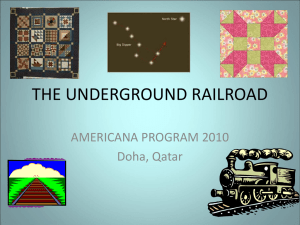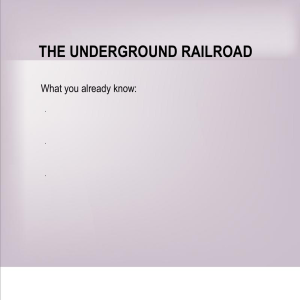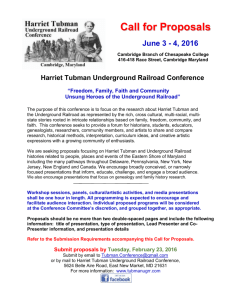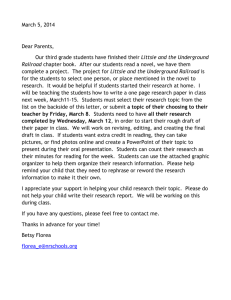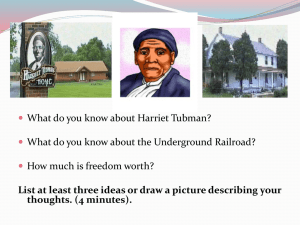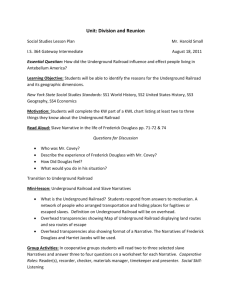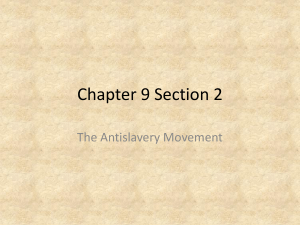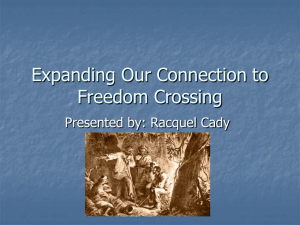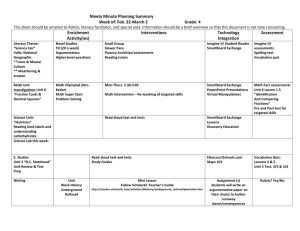Nicole Muehlenkamp/Debbie Smith/Hope
advertisement
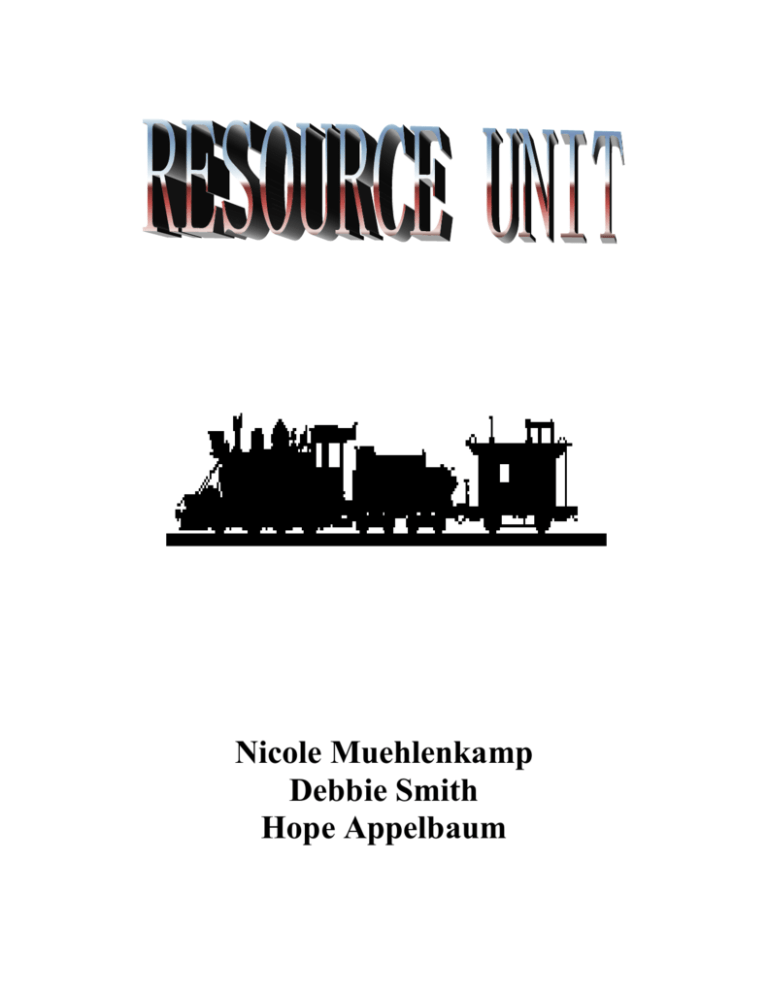
Nicole Muehlenkamp Debbie Smith Hope Appelbaum TABLE OF CONTENTS Section Page Number Introduction……………………………………………………….…….. 3 Content…………………………………………………………………. 4 Objectives………………………………………………………………. 5 Activities……………………………………………………………….. 7 Evaluation……………………………………………………………… 8 Instructional Resources………………………………………………… 10 Teacher References…………………………………………... 10 Media References…………………………………………….. 10 Student References…………………………………………… 14 2 INTRODUCTION Before the Civil War in the 19th century, there was tons of controversy on slaves and freedom. Many people in the United States had slaves, and the slaves had no personal freedom. The thousands of slaves could not have everything that they wanted— marry someone; leave their home, etc. Slaves tried to escape from freedom to Canada so they can have everything that they wanted. The Underground Railroad was a chain of sympathizers who provided a system of escape before the Civil War for slaves who ran away from the South to the free states and Canada. The slaves suffer for help and their life so they traveled on an Underground Railroad, but it was very dangerous trip for escaping slaves since no train cars or tracks. This resource unit will be about the Underground Railroad that the fifth graders will learn. They will learn about different slaves, freedom, how, why, when, where, and what did it happen, its history, and conductors. The students will participate in several in-class activities, simulations, videos, and the Internet. The knowledge gained will become used to all the African Americans around the students. The main purpose of this unit is for the students to become interested and enthusiastic about the Underground Railroad and get the concept of the world that everyone has freedom and that it does not matter what color people are and where they come from. 3 SUMMARY OF CONTENT The “Underground Railroad” is not a Railroad at all, but a network of safe houses, abolitionists and pathways that helped lead enslaved people from the plantations of the South to the freedom of the North. The “slavery” issue was a major contribution in the separation of the United States into the “South” and the “North”. The “South” was a proponent of slavery, using the “indentured servants” for the purpose of personal profit. The “North” opposed slavery, choosing “freedom for all” as the motto. Ohio played an important role as a “free state” offering sanctuary and “safe houses” along the railroad pathway. Concepts Abolitionists Baggage Brakeman Conductors Emancipation Proclamation Flying Bondsmen Freedom Line Fugitive Slave Law Indentured Servant Operator Pilot Safe House Scattered Wagons Station Travelers Agent Black Grapevine Bypass or Runaround Drinking Gourd Enslaved Forwarding French Leave Jumping Off Place Load of Potatoes Patter Roller Quilts Sanctuary Shepard Station Master “The Wind Blows From The South Today” 4 OBJECTIVES Students will develop an understanding of geographic concepts and processes as needed to examine the role of culture and the environment in the location and distribution of human activities. Analyze the effects of economic growth on the standard of living in the South. Students will be able to describe how plantation workers used natural, capital and human resources. Students will predict the effects of living in a given geographic setting on people's lives and journal these ideas. Students will recognize how people of the state and nation are linked by transportation and communication networks and its value. Students will demonstrate an understanding of the historical development and current status of economic principles, institutions, and processes needed to be effective citizens, consumers, and workers in American society. Given a map, students will plot and trace the routes of the slaves on their journey north by calculating the mileage each one walked. Students will be able to interpret maps given grid systems, directions, and scale. Learners will find the mileage within 10-15 miles accuracy, and describe in an essay, the severe risks and penalties involved in escaping. Students will define and use accurately the term Underground Railroad. Through a small group brainstorming session, students will name at least 3 characteristics of an Underground Railroad that accurately describes it. Given resource materials, student will be able to demonstrate ability to research and synthesize information by utilizing classroom resources. Students sill be able to identify famous railroad conductors. Students will exhibit technology skills by using multimedia sources provided in class for research use. Students will be able to define abolitionist, fugitive, Emancipation Proclamation, conductor, drinking gourd, and Underground Railroad. 5 The students will be able to articulate why slavery important to the South’s economy. During this unit of study, students will work cooperatively to recreate slave life. Students will be able to locate places, explore geographic info by interpreting various provided maps. Upon completion of unit students will be able to indicate the importance that Ohio had to do with the "road to freedom" and clearly express these ideas via journaling. Students will research where one of the closest houses is to our area and locate on map. Students will identify the need for slaves to escape to freedom. Students will identify quilt block patterns by name and by sight. Students will analyze quilt block patterns to find the symbolic meaning. Students will create a freedom quilt and evaluate directions from the school to the park. Students will conclude that freedom quilts played an important role in helping slaves make their way along the Underground Railroad. During entire unit of study, students will practice cooperative group learning skills. 6 ACTIVITIES The following activities will familiarize the students with the issues involving slavery. They will discover the people, places, and things that played an important role in the forming and executing of the “road to freedom”. 1. Create a time-line covering the existence and abolishment of slavery in the United States. 2. Examine how slave songs influenced the only original American music, Jazz. Bring in the accomplished Jazz musician, Bradley Sowash, for an innovative lesson on the history of Jazz. Examine the song “The Drinking Gourd”, and discover the meaning of the words. 3. Using the website: Routes of the Underground Railroad, look at the free states and the slave states. Compare the longitude and latitude of these states and determine why the South felt the need to enslave people. www.nyjournalnews.com 4. Research a famous Underground Railroad Conductor such as James Fairfield, Harriet Tubman, “The Moses of the Civil War”, and John Parker. 5. Create a painting of a quilt as a group project. The students will describe slavery and translate their ideas visually and verbally. They will then use mathematics to determine the perimeter and area of the quilt, of the sections of the quilt and of their own quilt square. They will use the website: The Underground Railroad Quilts for resource information. www.connectingstudents.com 6. Plot and trace the routes of slaves on their journey from the South to the North. They will explain all of the natural obstacles the slaves faced on their journey, and the students will calculate the mileage that the slaves walked along the Underground Railroad. 7. Take a walking tour of the “Safe Houses” located in the city of Springboro. 7 EVALUATION UNDERGROUND RAILROAD TEST Name:____________________________ Multiple Choice ( ) Read each question very carefully and circle your best answer. 1. How were quilts used on the Underground Railroad? a. to keep warm b. as coded maps c. to hide runaway slaves d. to hide food 2. What were some ways fugitive slaves traveled North? a. in boxes b. covered by sacks c. in a coffin d. all of the above 4. Which of the following was a good reason for slaves to try to escape in winter? a. there were less bounty hunters searching in the winter b. the snow made the roads less bumpy c. there was less vines in which to get caught d. runaways could throw snowballs at anyone chasing them 5. What was a Station? a. a place trains stopped to pick up runaway slaves b. a trap set by bounty hunters c. a song about Canada d. a safe house for runaway slaves Objective Questions ( ) Read each question very carefully and write a short essay that answers the question completely (no more than 3 sentences). 6. What is the Drinking Gourd? ________________________________________________________________________ 8 ________________________________________________________________________ ________________________________________________________________________ 7. Why would runaway slaves 'Follow the Drinking Gourd?' ________________________________________________________________________ ________________________________________________________________________ ________________________________________________________________________ Short Essay ( ) Read each question very carefully and write a short essay that answers the question completely (no more than one page). 8. If slavery becomes legal again today, would you choose to be a slave owner? Why or Why not. Write at least a paragraph and support your answers on the back of this test page. 9. Explain in at least a paragraph what was the Underground Railroad and where it was located. Be sure to include what a conductor is and name one in your answer. Use the back of this test, if you need more room you may attach a piece of paper. 9 INSTRUCTIONAL RESOURCES Teacher References: Headings, Michael D. Teaching American History with the Internet. Classroom Connect, Inc: Pennsylvania, 1997. This book features ready-to-go Internet lesson plans, online projects, and classroom activities for teachers. It has dozens of interesting teacher-created lesson plans, activities, and student handouts. Jarolimek, John, Allen Y. King, Ida Dennis, & Florence Poter. The United States and the other Americas. Teacher’s Edition. Macmillian Publishing Company: New York, 1985. A unit of Underground Railroad had different ways of living that had formed in the North and South. The growth of slavery and a movement to end slavery made the differences worse. The lesson of the unit had different information on participating in discussions, making inferences, listening for information, locating places on a map, and identifying a problem and solutions. Stanchak, John. Civil War: Eyewitness Books. Hardback. Dorling Kindersley, 2000. From Bleeding Kansas to Reconstruction, Civil War springs to life in 29 doublepage spreads. Short articles are enhanced with hundreds of finely detailed photos, sketches, prints, and portraits, along with close-up views of weapons, uniforms, flags, documents, and other artifacts. Illustrations are extensively captioned and many have separate labels with pointer lines. Endpaper maps show the Union and Confederacy— states, major cities, battle sites, forts, and territories. It has all different kinds of headings including Underground Railroad. The Civil War News. Newspapers & guide. McDonald, 2000. This is very good for teachers to use this for social studies because it helps them to check on their students’ knowledge of what they’ve learned. This is a creative way for students to show what they have learned about the war between the states. Students research and write articles (in notebooks or with computers) about the Civil War, then transfer their work to these newspapers printed on durable poster paper. Each two-sided 17” x 22” form contains 13 story leads (samples: Abolitionists hailed as heroes, causes of the war, Medical treatment in the field), a classified section, two boxes for drawings, and one report-your-own story space. Media References: Snyder, Tom. American History Inspirer: The Civil War. CD-ROM (Mac/Windows) & guide. 1997. 10 Intertwining geography and history, this fast-paced game takes students on a scavenger hunt through time and space to introduce key events and trends in antebellum and Civil War America. Users are randomly placed somewhere in the U.S. between 1820 and 1865, and earn points by traveling to states with specific characteristics that were either contributing factors to the Civil War or measures of the war’s effects. Teachers may add their own data to create custom game categories. It comes with reproducible handouts, lesson plans, and a resource list. A History of Slavery in America. VHS videocassette. Surveys the history of slavery, from the notorious “middle passage” from Africa to Southern plantations, to the Civil War, Reconstruction, and Redemption. In addition to an extended section on Harriet Tubman and the Underground Railroad, this comprehensive program explores such topics as slave resistance, the slave family, abolitionism, rights denied to slaves, slave religion, Emancipation, and the postwar political situation for blacks. Historical narration and period illustrations are interspersed with in-depth discussion of the issues by prominent African-American historians and scholars. A Woman called Moses. VHS videocassette. Starting with her “early years of midnight” on a Maryland plantation, this 1978 epic drama re-creates the life of Harriet Ross Tubman: her escape from slavery at age 29, her service on the Underground Railroad conducting hundreds of slaves to freedom, her perilous spying for the Union, and her post-war leadership of the suffragette movement. Causes of the Civil War. VHS videocassette. Schlessinger, 1996. Tracing the U.S. history from the precolonial era to the Cold War years, these dynamic programs explore events, eras, and the lives of both key figures and everyday people. Thoroughly researched, this comprehensive series supplements any standard text for the entire year’s curriculum. An entertaining mix of archival film and stills, reenactments, dramatic readings, and interviews with historians provides facts in context and from many perspectives, including those of often-underrepresented groups. This is very interesting video to use for the entire year because every topic is focus on the causes of the Civil War. Clinton, Catherine. The Black Soldier: 1492 to the Present. Hardback. Houghton Mifflin, 2000. From Harriet Tubman’s efforts as a Union spy during the Civil War to Henry Flipper (the first black graduate of West Point) and General Colin Powell, the roles of people of color in the armed forces weave through the larger story of discrimination, prejudice, integration, and finally, greater acceptance of black soldiers in the American services. 11 Davis, Scott Hilton, Cheryl Magill, & Nigel Reed. The Freedom Station. VHS videocassette. 1990. A dramatization set at a stop on Maryland’s Underground Railroad during the 1850s. A young escaped slave and a farm girl from an abolitionist family meet and discover the difference between the reality and the idealized concept of freedom. Focused on a short span of time in the basement, it is an evocation of the perilous route to freedom provided by Maryland’s Harriet Tubman, known as “Moses” to the more than 300 slaves who escaped with her aid. Herbert, Janis. The Civil War for Kids: A History with 21 activities. Paperback. Chicago Review, 1999. Hands-on activities such as making butternut dye for a Rebel uniform, baking hardtack, learning military drills, decoding wigwag signals, and reenacting battles enliven this history of the Civil War. Richly illustrated with line art and photographs, the text includes sidebars on topics fascinating to young students: for instance, the Underground Railroad, drummer boy Johnny Clem, and animal mascots traveling with the troops. Walbridge, Mike. African-American Heroes of the Civil War. Reproducible activity book. J. Weston Walch, 2000. The courage of Fredrick Douglass, Harriet Tubman, Robert Smalls, and other African American heroes is explored through extensive readings and a variety of activities. Six profiles of four to six pages of easy-to-read text precede a glossary, vocabulary activity, reading comprehension questions, creative project, map activity, and other reading on similar heroes. Underground Railroad: Escape from Slavery. VHS videocassette, 9 photocopy masters, guide. United Learning, 1998. This basic overview of slavery uses reenactments, location filming, and historical artwork to show how forces like the Fugitive Slave Law, the Dred Scott case, and the publication of Uncle Tom’s Cabin transformed antislavery sentiment into action by a loose-knit group of free blacks and sympathetic whites who helped hundreds reach a Northern state or Canada before the Civil War. Race to Freedom: The story of the Underground Railroad. VHS videocassette. A critically acclaimed teleplay originally shown on “The Family Channel,” this realistic program follows a group of slaves seeking freedom. Helped by a Canadian abolitionist, four slaves risk torture and death by joining the Underground Railroad. An excellent springboard for discussions on abolitionists, the Underground Railroad, and why only 40,000 blacks successfully reached Canada gaining their freedom. 12 Perspectives on History Series: The Underground Railroad. Paperbacks. Discovery Enterprises. Selections from journals and diaries, newspaper accounts, the evaluations of historians, poems, historical fiction, and other primary and secondary sources help students savor the tang of actual lives in America’s past. These engaging excerpts— including firsthand testimony from teenagers living at the time—are linked with brief commentary in a concise and readable format. Freedom from Slavery Posters. 10 Posters. Perfection Learning. A set of ten three-color posters, which tell the story of the fight against slavery with period photographs and quotations. Underground Railroad. Simulation. Interact, 2000. Students experience the Underground Railroad through the eyes of “passengers,” “conductors,” and bounty hunters. Cooperative groups learn about the structure of the railroad, stories of escape, major routes, agents of the railroad, and the consequences of detection before they simulate an escape across school grounds. Includes teacher instructions, reproducible readings and glossary, student directions, rubric, and other reproducibles. Student guide sheets contain summary questions and debriefing essay prompt. Parks, Gordon. Solomon Northup’s Odyssey. VHS videocassette & Paperback. Based on Solomon Northup’s best-selling autobiography Twelve Years a Slave (published in 1853), this production chronicles the experiences of a free black man who was kidnapped and sold into slavery in Louisiana. Away from his family for 12 years, he was forced to endure numerous hardships and brutalities. When he was finally freed, he pledged to reveal his experiences to the general public. Beautifully photographed and emotionally moving, the program dramatically depicts the realities of slave life, as it existed before the Civil War. Dee, Ruby. Roots of Resistance—A story of the Underground Railroad: The American Experience. VHS videocassette. Evoking a complex view of the issues, this program uses interviews, slave narratives, vintage photographs, archival documents, location footage, re-creations, and the haunting music of spirituals to cover the plantation system, Nat Turner’s rebellion, the Underground Railroad, the Fugitive Slave Law, and African-American participation in the Civil War. Animated Hero Classics. VHS videocassette. Schlessinger, 1997. 13 Each episode combines a dramatic storyline with an accurate portrayal of the time period in which the person lived. The videos can be used for notetaking with prepared questions and are ideal for individual or group research. In addition they motivate students to find out more about the heroes portrayed. Great Black Americans: Poster Series. 20 Posters. Knowledge Unlimited, 1988-91. Original artwork distinguishes these full-color portraits of accomplished black Americans. The 22”h x 17”w posters describe the life and achievements of 20 persons who succeeded in spite of prejudice and made valuable contributions to American society. Black History Poster Series: Harriet Tubman. Poster. Pomegranate, 1993-94. She stands in formal pose, clad in a stiff black dress, her face and bearing bespeaking the dignity, courage, and determination of a “conductor” on the Underground Railroad. Black Americans of Achievement Video Collection. VHS videocassettes. Library Video, 1992-94. This collection of informative video biographies of outstanding African Americans (Harriet Tubman) intersperses interviews of authorities on black history with fascinating archival footage and stills, historical background, quotations, and period music. The Black Experience: American Historical Images on File. 288 photocopy masters in 3-ring binder. 1990. More than 250 reproducible illustrations and photographs serve as a visual primary source evidence of important people and events in African American history. Among topics depicted are the distribution of slaves in the colonies, Nat Turner, Harriet Tubman, blacks in the West, W.E.B. Du Bois, the founding of the NAACP, Langston Hughes, Martin Luther King, Jr., and the rise of the black middle class. Images include portraits of famous people; woodcuts and etchings with contemporaneous depictions of life under slavery and in the abolition movement; and handbills, broadsides, and posters. Student References: Adler, David A. A Picture Book of Harriet Tubman. Scholastic, Inc: New York, 1992. Harriet Tubman was born a slave. She hated being a slave, so escaped slavery on the Underground Railroad. During her life, Harriet helped lead over 300 slaves to freedom on the Underground Railroad. Lawrence, Jacob. Harriet and the Promised Land. Simon & Schuster Children’s Publishing Division: New York, 1968. 14 A brief biography in verse about Harriet Tubman and her dedicated efforts to lead her fellow slaves to freedom. Levine, Ellen. If you traveled on the Underground Railroad. Scholastic, Inc: New York, 1988. This book describes what it was like to be a slave trying to escape to freedom on the Underground Railroad. Mosher, Kiki. Learning about bravery from the Life of Harriet Tubman. Rosen Publishing Group, Inc: New York, 1996. Demonstrates how bravery enabled Harriet Tubman, a slave, to escape to freedom, and subsequently bring more than 300 other people out of bondage. Porter, Connie. Meet Addy: An American girl. Pleasant Company Publications: Wisconsin, 1993. In 1864, after her father and brother are sold to another owner, 9 year-old Addy Walker and her mother escape from their cruel life as slaves in North Carolina to freedom in Philadelphia. Schroeder, Alan & Jerry Pinkney. Minty. Puffin Books: New York, 1996. Young Harriet Tubman, whose childhood name was Minty, dreams of escaping slavery on the Brodas Plantation in the late 1820’s. Stanchak, John. The Visual Dictionary of the Civil War. Hardback. Dorling Kindersley, 2000. Images with explanatory text help students envision the Civil War. Students who know the word but can’t picture what it refers to can start with the index and then turn to a photograph; students who know what something looks like but don’t know what it is called can turn to a thematic page and read the caption under the picture. The 27 twopage chapters include beautifully detailed images of such items as a reconstruction of a butternut-dyed Confederate uniform, a photograph of sharpshooters’ spectacles, a crosssection of the Monitor, and, in one set of images, a painting of General Sherman next to a photograph of the actual hat he wears in the portrait. Winter, Jeanette. Follow the Drinking Gourd. Alfred A. Knoff, Inc: New York, 1988. By following the directions in a song, “The Drinking Gourd,” taught them by an old named Peg Leg Joe, runaway slaves journey north along the Underground Railroad to freedom in Canada. 15 In American History: The Underground Railroad. Hardback. Enslow, 1996-2000. Carefully researched and supported with source documents, photographs, and maps, these books encourage students to examine Underground Railroad in greater depth. Attention is paid both to larger historical issues and to the small details that can bring a bygone time and place into sharp focus. Study aids include timelines, chapter notes, and reading lists. The Blue and The Gray: America’s Civil War 1861-1865. Book with reproducible pages. Encouraging active learning, this collection of investigative and creative activities involves students in the study of the causes and effects of the Civil War. Students play word games, study the life of Abraham Lincoln, make charts about abolitionists, and further examine the War between the states by creating a mural depicting major events of the 19th century that had an impact on the Civil War, drawing a map of the country in 1863, describing the economies of the North and South, and keeping diaries of journeys along the Underground Railroad. 16
